|
Subpage
bugs in the garden: "Water
bugs"
Shield
bugs (Pentatomoidea)
Plantbugs
(Miridae)
Seed
bugs (Lygaeidae)
Cicadas
 Nederlands /
Dutch Nederlands /
Dutch
True bugs (Hemiptera) in the garden.
Information about bugs:
True bugs can be found both in and on water and on land. They also have a
sucking mouthparts known as a rostrum.
With this rostum they suck juices from all kinds. That can be plants and seeds, but also insects and other animals. They belong to the order Hemiptera
like aphids
and cicadas.
The true bugs have forewings that are hardened at the base and membranous
at the tips. They sit flat over the abdomen hiding the membranous hind
wings. Hemiptera
means “half wing. They
are held flat on the back, with the ends overlapping. (Hardened
forewings like the beetles have, but the forewings of beetles meet
together in a straight line on their back)
The larva (nymph) resembles a miniature wingless adult, although their colour and markings may be very
different. The nymphs progress
through a series of moults (known as instars) .
The wings are developed in the last instar. ( incomplete metamorphosis, there is not a pupal
stage). There are five instars.
In and near water, these families are on this website: Corixidae, Gerridae,
Hydrometridae, Nepidae, Naucoridae, Notonectidae, Saldidae.
There are many families. Well known is the superfamily Pentatomoidea, which is divided into 14-15 families.
Such as the families Stink bugs (Pentatomidae), Acanthosomatidae, Burrower Bugs
(Cydnidae), Jewel bugs (Scutelleridae), ebony bugs (Thyreocoridae) with in the Netherlands
only the Thyreocoris scarabaeoides and since 2021 the family Plataspidae with in the Netherlands
only the Thyreocoris scarabaeoides.
Other true bugs families on this website are: Minute pirate bugs, Flower bugs (Anthocoridae) , Squash bugs,
Leaf-footed bug (Coreidae) , Seed bugs, Ground bugs (Lygaeidae),
Plant bugs (Miridae), Nabidae, Scentless plant bugs (Rhopalidae), Reduviidae,
Lace bugs (Tingidae).
|
I have made subpages of some families. On this page I have placed a photo of
one species of the family and a link.
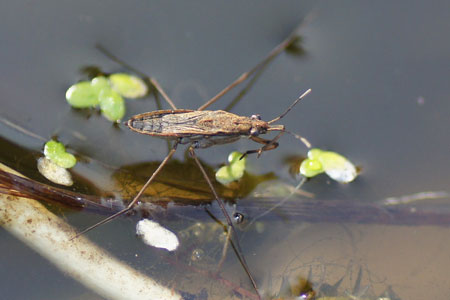
Common
pond skater (Gerris
lacustris) Family Gerridae.
|
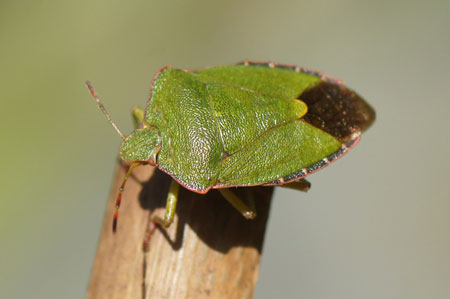
Green Shieldbug (Palomena
prasina). Family Stink bugs (Pentatomidae). Superfamily
Pentatomoidea
|
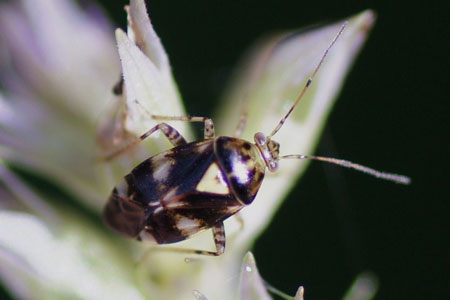
Common
Nettle Capsid (Liocoris tripustulatus).
Tribe: Mirini. Family: Plant Bugs (Miridae).
|
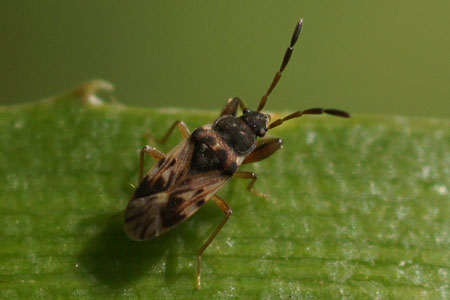
Scolopostethus affinis. Subfamily
Rhyparochrominae.
Family Seed Bugs or Ground Bugs
(Lygaeidae).
|
Closely related:
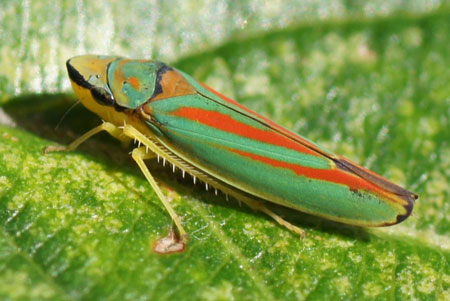
Closely
related to True bugs: Rhododendron
Leafhopper
(Graphocephala fennahi). Subfamily Cicadellinae. Family
Cicadellidae.
|
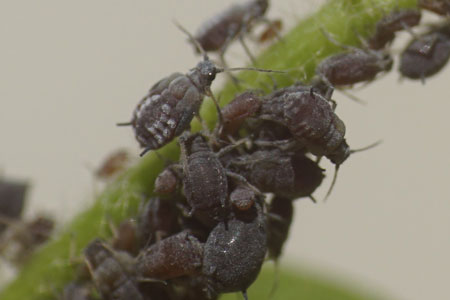
Closely
related to True bugs: Ivy aphid (Aphis
hederae). Tribe Aphidini. Subfamily Aphidinae. Family Aphids (Aphididae).
|
Squash Bugs, Leaffooted Bugs (Coreidae).
Elongated oval brown bugs. The abdomen has a clear edge. They are herbivores. In other parts of the world (especially the tropics) there are many more species. These can be large and
are called Leaffooted bugs because the shins of the hind leg are often widened. Like the Leptoglossus
occidentalis. But that bug
isn't originally from Europe.
 .. ..
 . .
 Dock leaf bug, brown squash bug (Coreus
marginatus). Family: Squash bugs, Leaffooted bugs (Coreidae).
Dock leaf bug, brown squash bug (Coreus
marginatus). Family: Squash bugs, Leaffooted bugs (Coreidae).
A striking brown bug with a broad oval abdomen. It looks like the Arma
custos. But it is easily recognized by the dark tips of the antennae. At the front of the head are two thorns between the antennae that almost touch each other with the points; these thorns don't occur in any other Squash bugs. It looks a lot like the Enoplops
scapha.
The dock leaf bug is a plant eater. He sucks the juices from plants and
fruit. The picture was taken on May 5, 2010. It is sitting on the leaf of
a berry bush. They prefer dock and knotweed.
It can defend it selves by spreading a smelly brown liquid. Both nymphs and adults
overwinter.
Length 12 to 15 mm. Europe, North America. Foto's 5-5-2010, 29-4-2019, 16-5-2019.
German: Lederwanze, Große
Randwanze, Saumwanze French: punaise
brune, corée
marginée

 Photos 19-8-2013. Two nymphs, different instars.
Photos 19-8-2013. Two nymphs, different instars. |
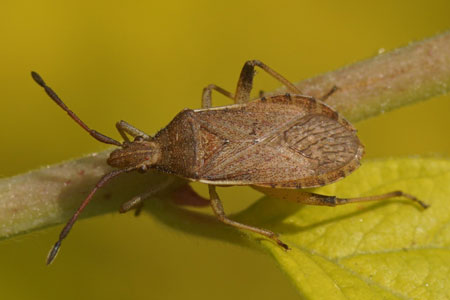 .. ..
 Slender-horned Leatherbug
(Ceraleptus lividus).
Family: Squash bugs, Leaffooted bugs (Coreidae).
Slender-horned Leatherbug
(Ceraleptus lividus).
Family: Squash bugs, Leaffooted bugs (Coreidae).
A brown bug with a black stripe over the eyes and a light border along the front wings.
Host plants: Fabaceae like clover, medick and vetch. Especially on sandy soil.
Adult bugs overwinter and can be found throughout the year. Length 10-11.5 mm. Europe, Asia. Photos 18-5-2019. |
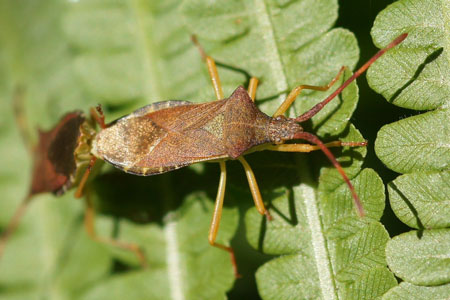 .. ..
 Gonocerus acuteangulatus.
Family: Squash bugs, Leaffooted bugs (Coreidae).
Gonocerus acuteangulatus.
Family: Squash bugs, Leaffooted bugs (Coreidae).
The adult bug is similar to the Dock leaf bug. But it has narrower
abdomen. The pale legs are also slim.
It has different foodplants.
Adults can be found throughout the year. The adult bugs overwinter in leaf litter.
Length 11 - 14 mm.
Central Asia, Europe. Originally in the Mediterranean. Photo 2-6-2011

 Nymph: Photo
12-7-2010.
Nymph: Photo
12-7-2010.
|
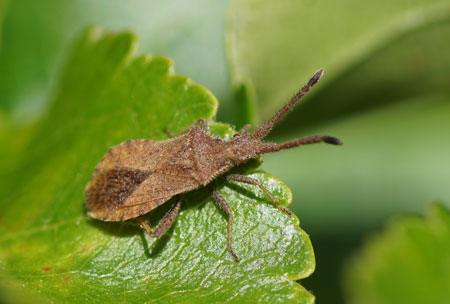 .. ..
 Coriomeris denticulatus.
Family: Squash bugs, Leaffooted bugs (Coreidae).
Coriomeris denticulatus.
Family: Squash bugs, Leaffooted bugs (Coreidae).
A small brown
squash bug. Pronotum, legs and antennae are bristly. On the side of the pronotum
are spines.
Food Plants: Fabaceae like black medic (Medicago lupulina), sweet clover (Melilotus), clovers. On calcareous or sandy soil, like here in the dunes.
Adults can be found throughout the year. Length 7 - 9 mm. Europe.
Photos 19-5-2020. |
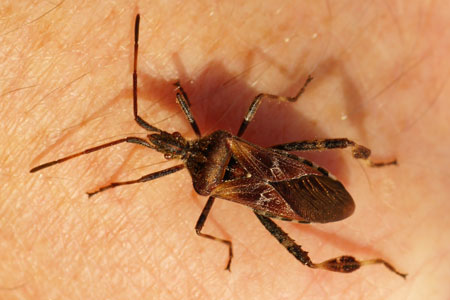 .. ..
 . .
 Western conifer seed bug (Leptoglossus
occidentalis).
Family: Squash bugs, Leaffooted bugs (Coreidae).
Western conifer seed bug (Leptoglossus
occidentalis).
Family: Squash bugs, Leaffooted bugs (Coreidae).
Native in North America west of the Rocky
Mountains. It has spread now to the east coast. In 1999, for the first time
it was discovered in Europe in northern Italy and since that time it has spread
in Europe. (France, Germany in 2006 Great Britain, Belgium, the Netherlands 2007)
The shins of the hind legs are widened. The top is reddish brown. In the middle of the elytra
runs a small white zigzag nark (sometimes less visible)
The bug sucks seeds and flowers of signal trees. Mostly pine but also spruce
like the Douglas fir (Pseudotsuga menziesii), white spruce (Picea glauca). In America it is a pest of conifer seed nurseries. In Europe, I think
there are no problems.
It hibernates and is often found in hauses. My wife found this bug in the hallway. To my great joy, because
this was the first time I saw it in real.
Length 15 to 20 mm.
Foto's 26-10-2014. German: Amerikanische Kiefern, Zapfenwanze. French:
Punaise américaine du pin.
|
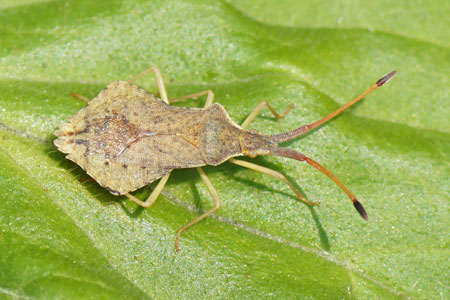 Rhombic leatherbug (Syromastus rhombeus). Family: Squash bugs, Leaffooted bugs
(Coreidae).
Rhombic leatherbug (Syromastus rhombeus). Family: Squash bugs, Leaffooted bugs
(Coreidae).
Recognizable by the broad, diamond-shaped abdomen. It lives on plants from the pink family (Caryophyllaceae). Including mouse-ears (Cerastium), camion (Lychnis), starwort (Stellaria) and starwort (Spergula).
Length 9,5-11,5 mm. Photo 31-5-2025.
|
Assassin bugs (Reduviidae).
They are slender predatory bugs with a very small head and a solid, short,
curved rostrum. They are all over the world and they often have striking (red)
colours, like this  Rhynocoris
spec, photographed in France. The Rhynocoris annulatus occurs in the Netherlands, but not in our garden. Rhynocoris
spec, photographed in France. The Rhynocoris annulatus occurs in the Netherlands, but not in our garden.
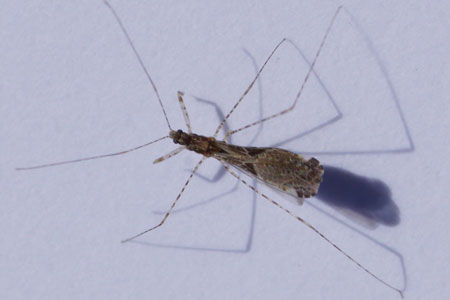 .. .. . .
 . .
 Empicoris culiciformis.
Family:
Assassin bugs (Reduviidae).
Empicoris culiciformis.
Family:
Assassin bugs (Reduviidae).
A small predatory bug with long thin legs and antennae. It looks like a gnat. Legs and antennae with white and black rings (about the same size). There are two similar species in the Netherlands. Empicoris vagabundus is larger (5.7-7.5 mm) and has narrow black rings around legs and antennae. Empicoris baerensprungi has not only a spine but also a lump on the
scutellum. (Detail photo)
The adult bug overwinters (maybe also the eggs). Attics, stables, chicken coops, rotting tree trunks. Here in ivy on the wall.
Length 3.7-5 mm.
Europe, Asia, North Africa and North America.
Photos 11-7-2016. |
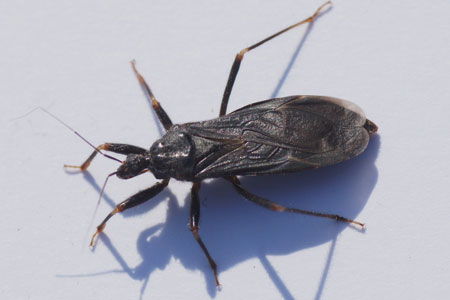 .. ..
 . .
 Masked hunter (Reduvius personatus). Family:
Assassin bugs (Reduviidae).
Masked hunter (Reduvius personatus). Family:
Assassin bugs (Reduviidae).
A brown to black predatory bug. It looks a bit like a large predatory fly,
for a large part of the forewings is transparent and the head is small. It hunts all kinds of insects.
It don't feed on human bled, but it can bite in self-defence. (It hurts
like a bee sting)
It hunts at night and hides during the day. It is attracted to light and
is also found in houses. (like the bug on the photo)
The eggs overwinter. The nymph has sticky hairs. It covers it selves with
dust, sand etc. It is well camouflaged. They are just like the adult bug
predators. They hide to catch the prey.
Length 15-18 mm.
Native to Europe and North Asia. Now also in North and South America and Australia.
Photos 7-7-2013. |
Scentless Plant Bugs (Rhopalidae).
In many species, the corium (the thickened, leathery, basal portion of an insect forewing)
is transparent. Plant foods. They are lacking well-developed scent glands.
On the head ate two ocelli.
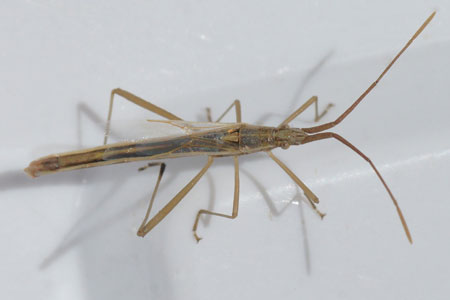 .. ..
 Chorosoma schillingii. Tribe Chorosomini.
Family Scentless Plant Bugs (Rhopalidae). Not in the garden but in the dunes
about 4 km from our house.
Chorosoma schillingii. Tribe Chorosomini.
Family Scentless Plant Bugs (Rhopalidae). Not in the garden but in the dunes
about 4 km from our house.
A long, slender, tan-green to green bug, resembling the mirid grass bugs. The wings cover two thirds of the body.
They feed on grasses and ripening seeds.
In the Netherlands generally in the dunes and higher sandy soils.
Length 13-16 mm. Europe, North Africa.
The eggs overwinter on grasses. June - October.
Photos 18-6-2017. |
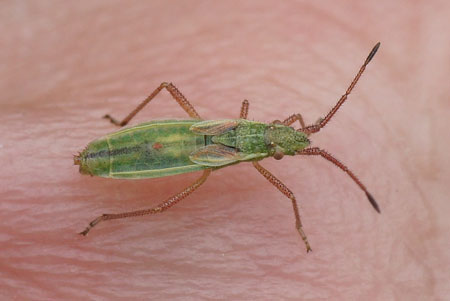 .. ..
 Reddish brown:
Reddish brown:
 . .
 Myrmus
miriformis. Tribe Chorosomini. Family Scentless Plant Bugs (Rhopalidae). Not in the garden but in the dunes
about 4 km from our house. Myrmus
miriformis. Tribe Chorosomini. Family Scentless Plant Bugs (Rhopalidae). Not in the garden but in the dunes
about 4 km from our house.
A small slender green bug, resembling the mirid grass bugs. The male can also be brown. The legs
and antennae are reddish brown. Usually they are like in the picture
brachypterous, but
sometimes they are macropterous.
They feed on grasses and ripening seeds.
Length 6.5-9 mm. Europe.
The eggs overwinter on grasses. June - October.
Photos 25-6-2015, 20-7-2015, 17-7-2017. |
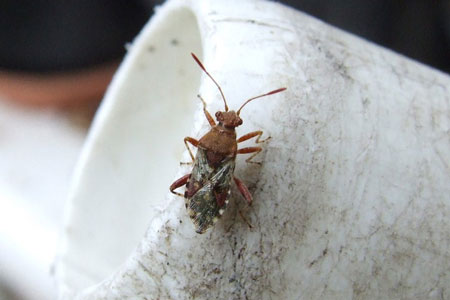 .. ..  . .
 . .  Rhopalus
subrufus. Tribe Rhopalini. Subfamily Rhopalinae. Family Scentless Plant Bugs
(Rhopalidae). Rhopalus
subrufus. Tribe Rhopalini. Subfamily Rhopalinae. Family Scentless Plant Bugs
(Rhopalidae).
A small bug sitting on the watering-can (June 2008)
It is a rather hairy bug.
Some are brightly colored, others drab or dark.
Rhopalus subrufus is often found on low vegetation in scrubby
areas. (on many plants)
The adults hibernate. Length: 6,5-7,7 mm.
Photos 18-4-2011, 23-4-2011, 18-9-2011. |
  Nymph Rhopalus subrufus (August)
.
Nymph Rhopalus subrufus (August)
.
 Male
and female 14-5-2010, 6-6-2012. Male
and female 14-5-2010, 6-6-2012. |
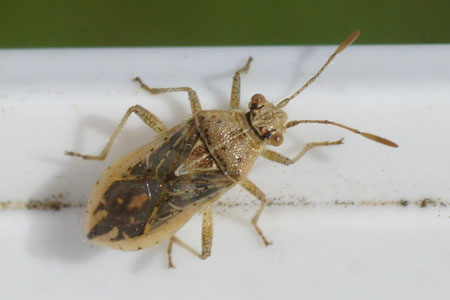 Rhopalus
parumpunctatus.
Tribe Rhopalini. Subfamily Rhopalinae. Family Scentless Plant Bugs (Rhopalidae). Not in the garden but in the dunes
about 4 km from our house. Rhopalus
parumpunctatus.
Tribe Rhopalini. Subfamily Rhopalinae. Family Scentless Plant Bugs (Rhopalidae). Not in the garden but in the dunes
about 4 km from our house.
A yellow-brown to reddish bug. On head, pronotum and scutellum iruns a thin pale line. The connexivum along the abdomen has sometimes black spots.
The adults hibernate.
Length: 6,2-7,5 mm. Photo 7-7-2016. |
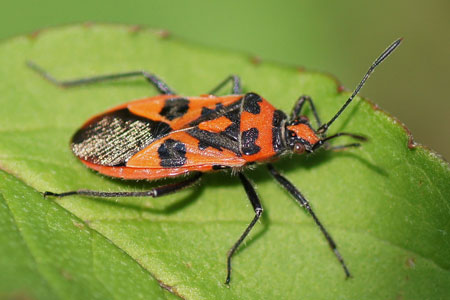 .. ..
 . .  Cinnamon Bug
(Corizus hyoscyami). Tribe Rhopalini. Subfamily Rhopalinae.
Family Scentless Plant Bugs (Rhopalidae). Cinnamon Bug
(Corizus hyoscyami). Tribe Rhopalini. Subfamily Rhopalinae.
Family Scentless Plant Bugs (Rhopalidae).
A difference with the Firebug is that the Corizus hyoscyami is black
on its head. It is hairy and the wing membrane has much veins.
You can find them on a range plants (like Verbascum). It prefers sandy areas with lots of
sun.
Length 9 - 11 mm.
For predators it tastes not good.
The adult bug overwinters. In May there are nymphs, which mature in September. So you see them all year.
Photos 6-10-2012, 11-9-2016. In 2012 for the first time in our
garden. |
 .. ..
 Stictopleurus abutilon. Tribe Rhopalini. Subfamily Rhopalinae.
Family Scentless Plant Bugs (Rhopalidae).
Stictopleurus abutilon. Tribe Rhopalini. Subfamily Rhopalinae.
Family Scentless Plant Bugs (Rhopalidae).
For the first time in the garden. They were also rare in my area. It is very similar to Stictopleurus punctatonervosus.
In herb-rich grasslands and roadsides with composites. Here on feverfew.
The adult bugs hibernate. Length 7-8.7mm. Photo 30-6-2023
|
Pyrrhocoridae.
There are about 300 species, mainly in the tropics and subtropics. The bugs of this family are usually very brightly colored. They suck on plants, especially
on seeds. Like plant bugs (Miridae), they don't have ocelli. An
ocellus, plural ocelli is also called a
simple eye or pigment pit. Many insects have three on their foreheads. They seem to distinguish light and dark.
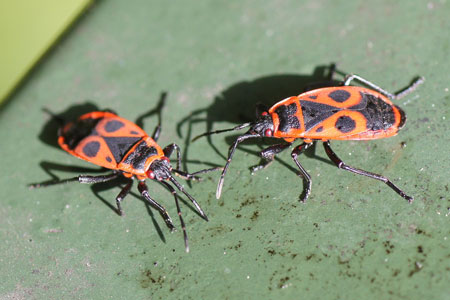 .. ..
 Firebug (Pyrrhocoris
apterus) Family Pyrrhocoridae.
Not in our garden, but on about 200 m. from our
home. Firebug (Pyrrhocoris
apterus) Family Pyrrhocoridae.
Not in our garden, but on about 200 m. from our
home.
Pyrrho-coris = red insect. a-pterus = without wings. But they have brachypterous wings.
Brachyptery means, that the wings are very reduced and non-functional. The
can't fly. Occasionally there are long winged firebugs (macropteer).
They are strikingly red with a black head. Also striking are the black triangle
and the two large black round spots.
You often see them in dense
groups near lime trees. They feed on the fallen leaves and seeds. They
live also on other plants, but don't cause much damage. They also feed on dead insects and sometimes even
living insects.
The firebug is a plant eater, but it causes little damage. Sometimes there
hundreds of firebugs on the same spot. Especially after a mild winter.
Augustus - May. They overwinter in colonies. Palaearctic. Length 10 - 12 mm.
Photos 29-9-2015.
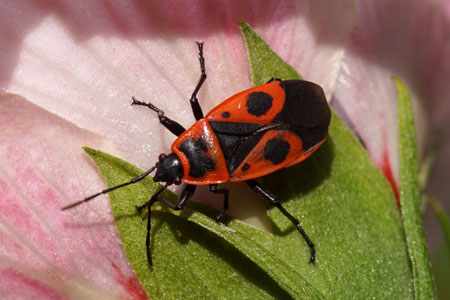 Firebug (P). Long-winged, macropterous.
Firebug (P). Long-winged, macropterous.
In 2024 I discovered this long-winged firebug in the garden. Probably from the place where I photographed them in 2015. Photo 23-9-2024
|
Pirate bugs (Anthocoridae).
Anthocoridae: Greek words anthos "flower" and Koris "bug. You can see they indeed regularly
on flowers looking for prey, because they are predatory bugs. They are small, somewhat flat bugs. Often
black or black with white and brown.
Subfamily Anthocorinae. Bugs from the subfamily Anthocorinae are mainly found in trees (leaves, bark), shrubs and herb layer.
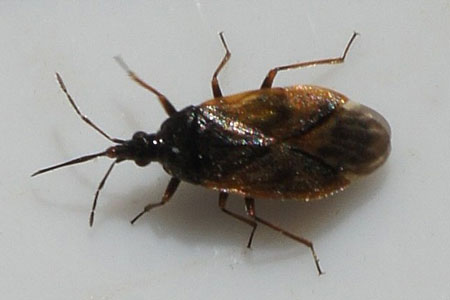 .. ..
 . .
 Acompocoris alpinus.
Subfamily Anthocorinae. Family Pirate bugs (Anthocoridae).
Not in the garden but in the dunes
about 4 km from our house.
Acompocoris alpinus.
Subfamily Anthocorinae. Family Pirate bugs (Anthocoridae).
Not in the garden but in the dunes
about 4 km from our house.
The bug has brown glossy forewings and the dark membrane has whitish lines.
These white marks are uncommon for the most bugs in this family. It looks
like the Tetraphleps bicuspis. The legs are
pale brown with a dark femur. The middle part of the second segment of the
dark antenna of the females is lighter. In males, the entire antenna is dark.
They feed on aphids, other small insects and live on conifers (pine and fir
and larch), but this bug I found in a
heather bush. Larvae are found in July and August. The whole year. The adult bugs overwinter under the bark.
Length: 3 - 3,6 mmEurope. Photos 1-10-2015. |
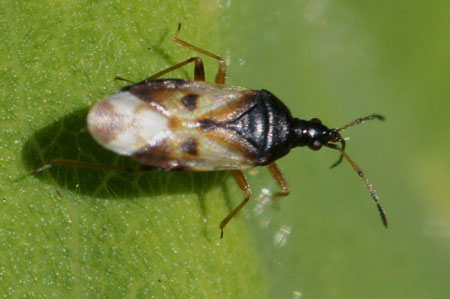 .. ..
 . .
 . .
 Common flower bug
(Anthocoris nemorum). Subfamily Anthocorinae. Family Pirate bugs
(Anthocoridae). Common flower bug
(Anthocoris nemorum). Subfamily Anthocorinae. Family Pirate bugs
(Anthocoridae).
It's a predatory bug. It
feeds on aphids, mites, insect eggs and other insects. It can
also suck plant sap, but cannot live without insects.
The forewings are glossy. The scutellum. pronotum and head are black. The second and third segment, for the most part light brown with a dark top. The first and last segments are black.
The adults hibernate.
Length 3,5-4 mm.
 Nymph Common flower bug
(Anthocoris Nemorum) stadium 5
Nymph Common flower bug
(Anthocoris Nemorum) stadium 5
|
 .. ..
 . .
 Anthocoris
nemoralis. Subfamily Anthocorinae. Family Pirate
bugs ( Anthocoridae). Not in the garden but in the dunes
about 4 km from our house. Anthocoris
nemoralis. Subfamily Anthocorinae. Family Pirate
bugs ( Anthocoridae). Not in the garden but in the dunes
about 4 km from our house.
Anthocoris nemoralis is very similar to the in the Netherlands rarer Anthocoris
butleri.
Anthocoris butleri survives only as Buxus predator of the Psylla buxi. Adult bugs can also be found on other plants.
In the dunes however are no boxwood plants nearby.
The forewings are compared with the Anthocoris nemorum darker and has a different pattern on the membrane.
They are also less glossy in some places. The first antenna segment is dark. The second antenna segment is
pale at the base.
Length. 3,5 - 4 mm.
The adults hibernate.
Photos 31-3-2014. |
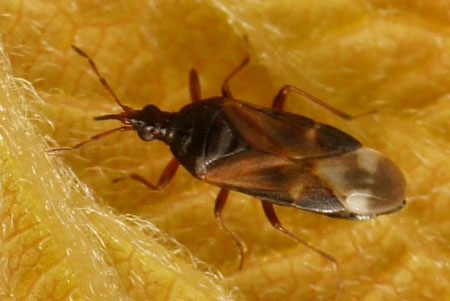 .. ..
 . .  Anthocoris
confusus. Subfamily Anthocorinae. Family Pirate
bugs (Anthocoridae). Anthocoris
confusus. Subfamily Anthocorinae. Family Pirate
bugs (Anthocoridae).
Anthocoris confusus is similar to Anthocoris nemorum and Anthocoris
nemoralis.
The lower part of the second antenna segment for the greatest part light brown. The front wings are darker than the Anthocoris
nemorum. It also has a slightly different pattern on the membrane.'It's
even more similar to the Anthocoris gallarumulmi.
Anthocoris confusus lives in deciduous trees (Here in a shrub). Length. 3,5 - 4 mm.
The adults hibernate.
Photos
9-5-2014. |
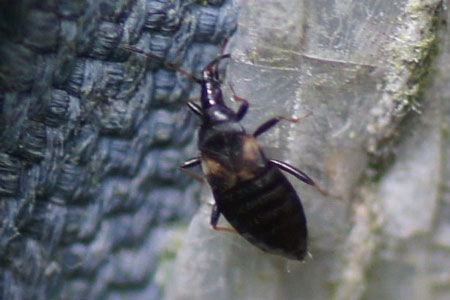 .. ..
 . .
 M
acropteer 26-7-2017: M
acropteer 26-7-2017:  Temnostethus gracilis. Subfamily Anthocorinae. Family
Pirate bugs ( Anthocoridae).
Temnostethus gracilis. Subfamily Anthocorinae. Family
Pirate bugs ( Anthocoridae).
Like the Orius it's a very small bug. A predator bug. They are usually (not always)
brachypterous.
On the wings is a white spot. Furthermore, the body is dark. The shins and tarsus
of the legs are light brown. Of the dark antenna is the second antenna segment
partely light brown.
Length: 2 - 2,5 mm.
All year.
Photos 17-9-2013, 1-8-2017 . |
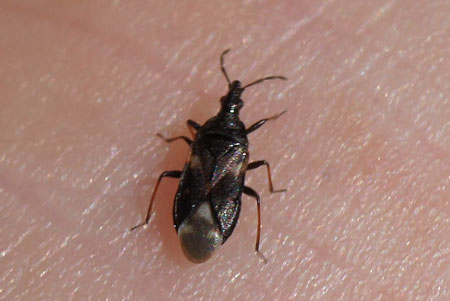 .. ..
 . .
 Temnostethus
pusillus. Subfamily Anthocorinae. Family
Pirate bugs ( Anthocoridae). Temnostethus
pusillus. Subfamily Anthocorinae. Family
Pirate bugs ( Anthocoridae).
A black and brown to black bug. The antennae are black to dark brown. Also, the membrane is blackish with three white spots. On the elytra, beside the dark scutellum is a slight stain.
They are often found on stems overgrown with moss and korstmosssen of deciduous trees such as ash and apple, but they are sometimes found on conifers. There they are looking for insects such as aphids, mealybugs and aphids.
Lengh: 2.5 to 3.1 mm.
The whole year. The adults overwinter.
Europe, Turkey and Caucasus. Photos 20-7-2015. |
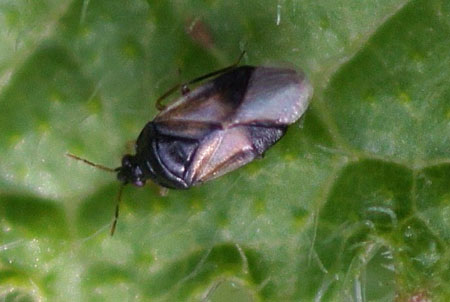 .. ..
 Flower bug, Orius spec. Subfamily
Anthocorinae. Family
Pirate bugs ( Anthocoridae). Flower bug, Orius spec. Subfamily
Anthocorinae. Family
Pirate bugs ( Anthocoridae).
This predator bug is similar to the Common flower bug but much smaller.
I find both species on Common Ragwort.
Fower bugs are also used as biological pest
control. Especially thrips. They also feed on spider mites and aphids,
insect eggs and some times pollen..
Length: 2-3 mm. The adults hibernate.
|
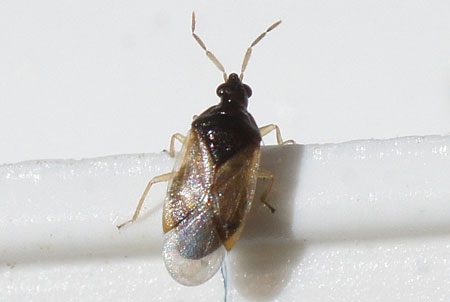 .. ..  Orius spec. Subfamily
Anthocorinae. Family
Pirate bugs ( Anthocoridae). Orius spec. Subfamily
Anthocorinae. Family
Pirate bugs ( Anthocoridae).
Another Orius, than the above-depicted Orius. I had shakenout some faded flowers of butterfly bush. The antennae, legs, cumeus are
palerer than other Orius. However, a generic name is again not possible. The following
species live in the Netherlands: Orius flagellum (exotic),
Orius horvathi, Orius laevigatus (exotic), Orius laticollis, Orius
majusculus. Orius minutus, Orius niger, Orius vicinus.
Length: 2-3 mm. Photos 28-8-2015. |
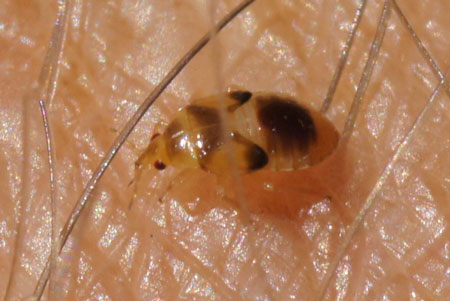 .. ..
 . .
 . .  Nymph Orius spec. Subfamily
Anthocorinae. Family
Pirate bugs ( Anthocoridae). Nymph Orius spec. Subfamily
Anthocorinae. Family
Pirate bugs ( Anthocoridae).
These are the nymphs of Orius (different stages, instars), which also were in faded flowers of butterfly bush. Most likely they belong to the same species as the adult
Orius. But that is not certain. One nymph I had overlooked until it stuck in my arm. It took a while, because I had to look for my camera. It itched about a week.
Photos 28-8-2015. |

 Photo
21-7-2012: Nymph Flower
bug (Orius spec) 5th instar. With its prey, a thrips. Photo
21-7-2012: Nymph Flower
bug (Orius spec) 5th instar. With its prey, a thrips. |
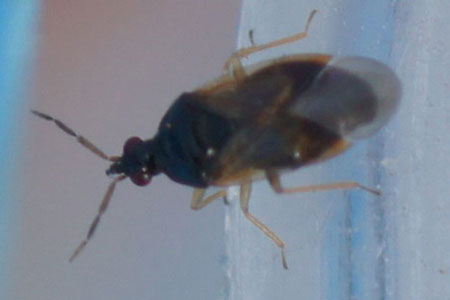 Orius
majusculus. Subfamily Anthocorinae. Family
Pirate bugs ( Anthocoridae). Orius
majusculus. Subfamily Anthocorinae. Family
Pirate bugs ( Anthocoridae).
An Orius, which can be determined from a photograph. A common bug in the Netherlands. It is common on willows and various
herbaceous plants. This Orius I found hempnettle.
Length 2.5 - 3.1 mm. Europe, Asia, North-America.
Photo 14-8-2016. |
Subfamily Xylocorinae. Subfamily Xylocorinae. Bugs from the subfamily Xylocorinae can be found in ants nests, nests, beetle corridors in the wood, compost heaps etc.
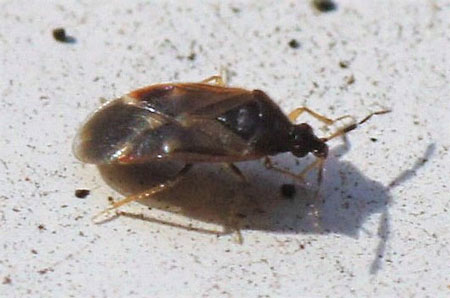 .. ..
 Buchananiella continua. Subfamily
Xylocorinae. Family
Pirate bugs ( Anthocoridae). Buchananiella continua. Subfamily
Xylocorinae. Family
Pirate bugs ( Anthocoridae).
It is a predatory bug, probably especially on dust lice (Psocoptera).
It is dark brown, sometimes reddish. Lower part of antenna segment 2 is pale. The dark membrane of the front wings has a pale edge. The legs are light yellow-brown.
It lives in places with many dust lice such as compost heaps, conifers (pines), ivy, fallen leaves.
Length: Between 2 and 3 mm.
The adults overwinter. This one was still active in December. Originally tropicaly like tropical Africa, tropical America, but now it has settled in many places in Europe.
Photos
18-12-2017. |
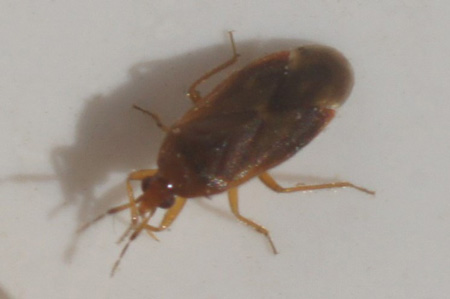 .. ..
 Cardiastethus
fasciiventris. Subfamily Xylocorinae. Family
Pirate bugs ( Anthocoridae). Cardiastethus
fasciiventris. Subfamily Xylocorinae. Family
Pirate bugs ( Anthocoridae).
It is reddish yellow / brown. Reddish yellow
antennae. Upper part of antenna segment 2 is dark, segments 3 and 4 are sometimes dark. A
greyish membrane. Yellowish legs.
It is rare in the Netherlands, but it spreads rapidly in a north-westerly direction.
Found for the first time in 2007.
It lives in places where there are also many dust lice such as conifers (pines), but also between barren leaves on fallen branches. This little bug was on
an Euonymus.
Length: 2.3-2.7 mm
The adults overwinter.
Europe, North Africa. Photos 7-4-2018. |
Nabidae.
They are predatory bugs and look
like small bugs of the family Reduviidae.
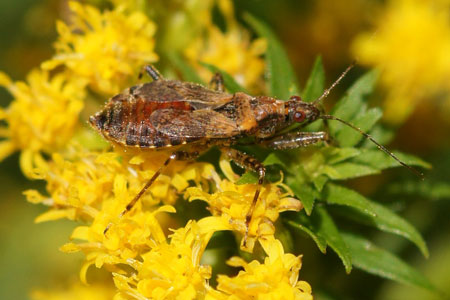 .. ..
 . .
 . .
 . .
 Himacerus mirmicoides. Subfamily Nabinae.
Damsel bugs (Nabidae).
Himacerus mirmicoides. Subfamily Nabinae.
Damsel bugs (Nabidae).
The adult bug is similar to a Himacerus apterus. But
this bug has long antennae. The Himacerus mirmicoides its feelers are
shorter or as long as the body. Usually they have short wings, but
sometimes the wings are fully developed.
They hibernate as adults. In July, August, you can find the larvae.
Photos adult dark bug (female) May 24 2009. Light brown adult bug: August
and September 2010. German: Ameisensichelwanze.
|
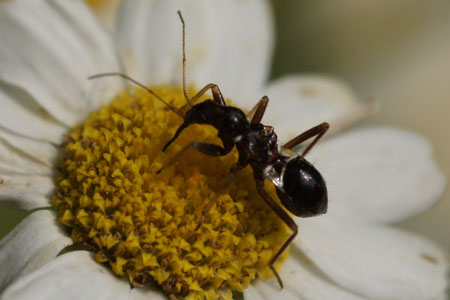 .. ..
 . .
 Very young nymph 1-7-2018:
Very young nymph 1-7-2018:  Nymphs Himacerus mirmicoides.
Nymphs Himacerus mirmicoides.
|
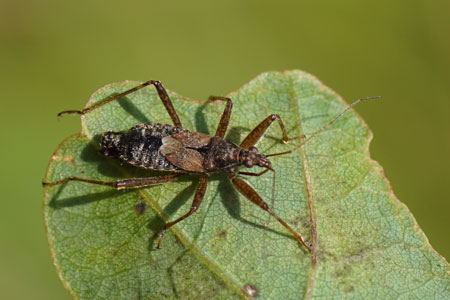 Himacerus apterus. Subfamily Nabinae.
Damsel bugs (Nabidae). Not in the garden but in the dunes
about 4 km from our house.
Himacerus apterus. Subfamily Nabinae.
Damsel bugs (Nabidae). Not in the garden but in the dunes
about 4 km from our house.
Photo 7-9-2021. |
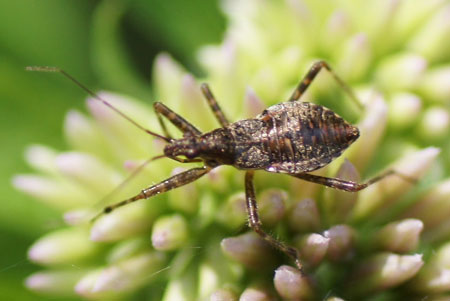 .. ..
 Himacerus apterus. Subfamily Nabinae.
Damsel bugs (Nabidae). Very young nymph 4-6-2016:
Himacerus apterus. Subfamily Nabinae.
Damsel bugs (Nabidae). Very young nymph 4-6-2016:  Not in the garden but in the dunes
about 4 km from our house.
Not in the garden but in the dunes
about 4 km from our house.
In the dunes I saw this nymph Himacerus apterus. The differences with the nymph Himacerus mirmicoides are clear. It looks a lot more like the adult bug.
The eggs overwinter. The eggs are laid in late summer.
Length 8-11 mm. July - October. Europe, Asia. Photos 17-7-2014.
|
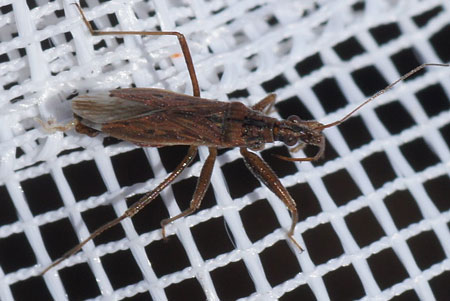 .. ..
 . .
 . .
 . .
 . .
 Heath Damsel Bug (Nabis ericetorum).
Subfamily Nabinae. Family Damsel bugs (Nabidae). Not in the garden but in the dunes
about 4 km from our house.
Heath Damsel Bug (Nabis ericetorum).
Subfamily Nabinae. Family Damsel bugs (Nabidae). Not in the garden but in the dunes
about 4 km from our house.
A bug with dark brown wings. The wings often just don't reach the end of the abdomen.
They overwinter as an adult bug. You can find them on the heath. Length 6.5 - 7 mm.
The whole year.
Photos 20-4-2015, 21-4-2015.
|
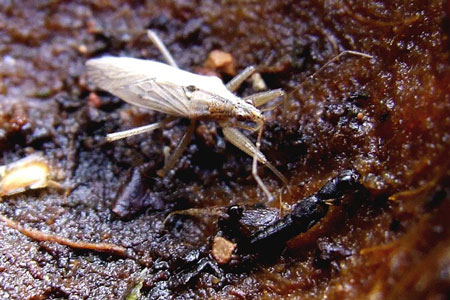 .. ..
 . .
 Field Damsel Bug (Nabis Ferus). Subfamily
Nabinae.
Damsel
bugs (Nabidae).
Field Damsel Bug (Nabis Ferus). Subfamily
Nabinae.
Damsel
bugs (Nabidae).
Very similar to the Nabis pseudoferus. Difference: The genitals and the
hairs at the apex of the corium.
They are both gray-brown in color and the pronotum is wider than
long.
Length 8.9 mm. They feed on all kinds of insects and overwinter as adult wants between the fallen leaves. I found this
Nabis on March 3 in a shell of a horse chestnut. On the first photo
there is also a rove beetle (stenus).
Eggs in May, June in the grass. Photos 3-3-2009. German: Rotbeinige
Baumwanze. |
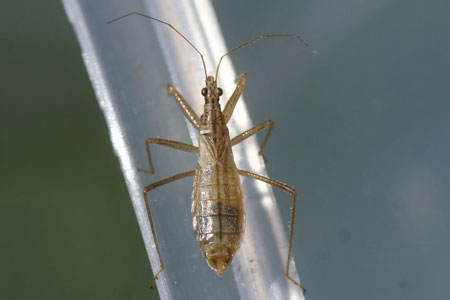 .. ..
 . .
 Nabis limbatus. Subfamily Nabinae.
Damsel bugs (Nabidae). Not in the garden but in the dunes
about 4 km from our house.
Nabis limbatus. Subfamily Nabinae.
Damsel bugs (Nabidae). Not in the garden but in the dunes
about 4 km from our house.
This species has very small wings and is therefore difficult to distinguish from a nymph
5th instar. The last picture is of a nymph. It is not certain it's this species, but because it was found in the same place it is likely. The females have broad abdomen. The males are smaller.
Similar species are the Nabis lineatus (The females are smaller and they are slightly
larger) and the Nabis flavomarginatus, which has longer wings.
The eggs overwinter.
Length 7-9 mm.
June - October. Central and Northern Europe.
Photos 3-9-2013, 16-9-2013. |
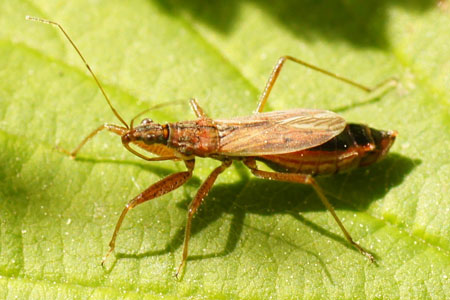 .. ..
 Nabis rugosus. Subfamily Nabinae.
Damsel bugs (Nabidae). Not in the garden but in the dunes
about 4 km from our house.
Nabis rugosus. Subfamily Nabinae.
Damsel bugs (Nabidae). Not in the garden but in the dunes
about 4 km from our house.
A red brown bug with pale brown wings. The forewings are often shorter than the abdomen. If they are longer, it is very similar to the Nabis ferus and the Nabis
pseudoferus.
They overwinter as adult bug. In May, the eggs are laid on blades of grass.
Length 6,5 - 7,5 mm.
The whole year. Europ, Central Asia.
Photos 13-5-2014. |
Stilt bugs (Berytidae).
Slender bugs, with long thin legs. The end of the thighs and antenna segments are often thickened.
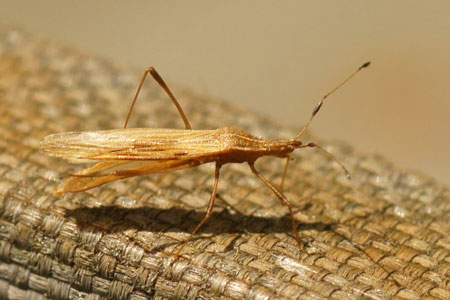 .. ..
 . .
 Berytinus minor. Family Stilt
bugs (Berytidae).
Berytinus minor. Family Stilt
bugs (Berytidae).
A slender pale brown bug.
The end of both the first segment and the last segment antenna are thickened and
black. The second antenna segment is very short. The end of the
thigh is a little darker. The head is shorter than the pronotum.
Berytinus minor looks like Berytinus ceassipes. At Berytinus ceassipes the end of
thighs is much darker and the head and pronotum have about the same length.
They feed on restharrow, clover.
The adults overwinter. The whole year.
Length 5 - 7 mm.
Photos 23-4-2014.
|
Flatbugs (Aradidae).
These are bugs with a broad flattened body with often a ribbed surface. They
feed on fungi. To find a new food source they must be able to fly well. In the
family are the genera Aradus, Mezira, Neuroctenus and Aneurus.
 .. ..
 Aradus depressus. Family flatbugs (Aradidae).
Aradus depressus. Family flatbugs (Aradidae).
The Aradus depressus is distinguishable from relatives by the
pale shoulders and the second and third antenna segment are about as long.
They can be found under the loose bark of trees infested by fungi and feed on fungi.
They can be found throughout the year. Both the larvae and the adults are
overwintering. The bugs mate in the spring.
Length 5 - 6 mm.
Photos 10-6-2015. Europe.
|
Lace bugs (Tingidae).
lace bugs because the pronotum and forewings of the adult have a network of divided areas that resemble lace.
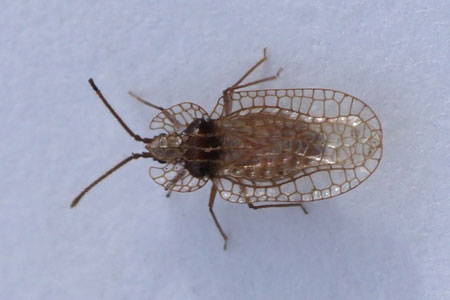 .. ..
 . .
 Derephysia foliacea. Family
Lace bugs (Tingidae).
Derephysia foliacea. Family
Lace bugs (Tingidae).
Host: ivy.
You can find them all year.
Length 3 - 3,5 mm.
Europe, North-Afrika. Now it is also recorded from North America. Photos 29-7-2015, 29-6-2012. |
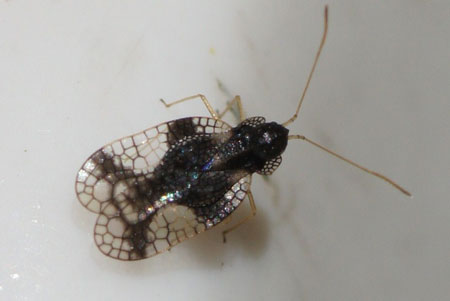 .. ..
 Stephanitis takeyai. Family
Lace bugs (Tingidae).
Stephanitis takeyai. Family
Lace bugs (Tingidae).
The Stephanitis takeyai is introduced in
Europe and the USA from Japan with the host Pieris japonica. Now it is
found in gardens and parks (also increasingly on Rhododendron).
Shiny whity, lacy wings with a dark spot. It resembles the native Stephanitis
Oberti, which
lives on rhododendron and bilberry, but which does not have a large
rounded, dark-coloured pronotum.
Eggs are laid along the midrib on the underside of the leaf.
Especially the big Pieris japonica can be damaged by both the nymph and the adult wants.
They damage the leaves by piercing them to suck the juices. Plants in full
sun have the worst damage.
The eggs overwinter. June - October. Two generations.
Length 3 - 4 mm.
Photos 18-9-2012.
|
 .. ..
 Acalypta parvula. Family
Lace bugs (Tingidae). Not in the garden but in the dunes
about 4 km from our house.
Acalypta parvula. Family
Lace bugs (Tingidae). Not in the garden but in the dunes
about 4 km from our house.
I tried to photograph a 3 mm large Stygnocoris sabulosus which ran around.
But I saw, when I looked at the picture, that there was also an Acalypta parvula
(see small picture). Unfortunately no sharp picture.
Oval in shape. Three keels on the pronotum.
Dry habitats among moss.
The adult bugs overwinter . Throughout the year. Length 1,6-2,5 mm. Europe.
Photos 28-9-2016. |
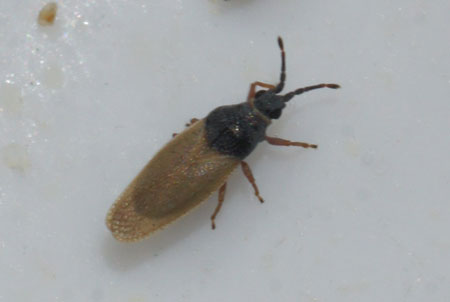 .. ..
 . .
 Agramma laeta. Family
Lace bugs (Tingidae). Not in the garden but in the dunes
about 4 km from our house.
Agramma laeta. Family
Lace bugs (Tingidae). Not in the garden but in the dunes
about 4 km from our house.
Head and pronotum and antennae are black. The front of the pronotum is yellow-brown. The wings are
also yellow-brown. Red-brown legs.
Host Plants: Rushes and sedges.
The adult bugs overwinter . Throughout the year.
Length 1.8-3.1 mm. Europe.
Photos 25-8-2015.
|
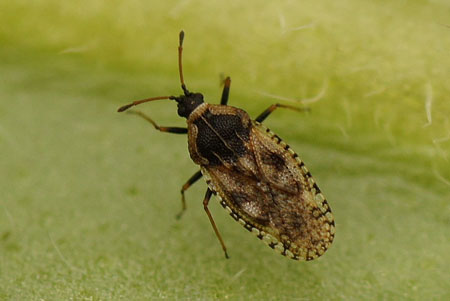 .. ..
 Nymph:
Nymph:  Dictyla echii. Family
Lace bugs (Tingidae). Not in the garden but in the dunes
about 4 km from our house.
Dictyla echii. Family
Lace bugs (Tingidae). Not in the garden but in the dunes
about 4 km from our house.
Head and pronotum are black. Near the head and on the sides the pronotum
is light brown. The brown antennae have a dark last segment. Brown legs
but the upper part of the thighs is black. On the pronotum are three keels. The middle keel
reaches the head, the other two are shorter.
The wings are light brown with dark markings.
Host Plants: Blueweed, Anchusa, Comfrey and other species of the Borage
family (Boraginaceae).
The adult bugs overwinter. Throughout the year.
Length about 3,5 mm. Europe, North Africa.
Photo 6-5-2014, 13-5-2014. Nymph 7-7-2016.
|
I want to thank Berend Aukema for the determination of many of my bugs.
Nederlands /
Dutch
 
Subpage bugs in
the garden: "Water
bugs" Shield
bugs (Pentatomoidea)
Plantbugs
(Miridae) Seed
bugs ( Lygaeidar)
Cicadas
Aphids
Subpage France:
Insects
France
|
